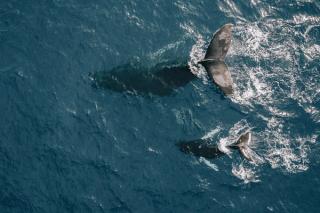
Is the Science-Based Targets initiative (SBTi) allowing offsets? What you need to know
by Emma Elbaum, James Balik-Meacher, Chloe Parkin, Caroline Dolan, Joanie Baczewski, Joesph Payne
View post

Human activities such as offshore seismic surveys, marine construction projects, oil and gas development, and military exercises can have considerable noise impacts on marine species. Predicting the extent of underwater noise propagation is a common aspect of the regulatory approval process for in-water projects. These predictions commonly identify the distance from the noise source or area of marine habitat with received noise levels above criteria. These criteria represent zones of potential adverse impact such as marine mammal hearing damage (permanent threshold shift, or PTS). Identified distances and areas are used to set stop-work zones to protect animals during noise-intensive activities. With knowledge of species population density, noise predictions are also interpreted to determine how many individuals may be affected, an important step in gaining permits and approvals for in-water work.
There are several approaches to underwater noise prediction, including a spreadsheet [1] or web-calculator [2] tool provided by NOAA’s National Marine Fisheries Service (NMFS), commercial software such as dBSea [3], and various consultant-developed scripts implementing recognized propagation algorithms. SLR has experience with all these approaches, which all provide a means to estimate distances and areas based on technical guidance [4] (2018) on PTS onset thresholds and marine mammal auditory sensitivity. This investigation compares the results obtained from the NMSF spreadsheet and dBSea for three marine mammal hearing groups: low-frequency (LF), medium-frequency (MF), and high-frequency (HF) cetaceans. Examples of LF cetaceans include blue whales and humpback whales. Belugas are MF cetaceans, while harbor porpoises are an example of HF cetaceans.
Early versions of the NMFS spreadsheet tool used broadband (not spectral) noise level metrics with a conservative weighting factor adjustment (WFA) to approximately represent frequency dependent effects and the different sensitivity of various marine mammals. Recent (July 2020) improvements to the NMFS tool enable optional input of the source spectrum, providing more refined predictions of impacts to different marine mammal groups. The NMFS tool uses a simple rule of thumb (often 15logR) relationship to estimate noise propagation at all frequencies over radial distance R.
An alternative tool used for the prediction of underwater noise in a variety of environments is dBSea. This also accepts spectral source levels and is capable of simulation of noise propagation effects that are not incorporated in the NMFS spreadsheet. These include seafloor reflection and absorption, sound speed profile in the water column, currents and bathymetry (depth variation in the project area). Considering these factors and others, dBSea calculates underwater noise propagation based on site-specific physical characteristics.
SLR has compared both prediction methods, the NMFS spreadsheet and dBSea. We used the same source input data to represent impact pile driving. When site conditions in dBSea are selected such that the propagation is broadly comparable to the assumed NMFS spreadsheet propagation relationship, the two methods differ depending on the applied WFA (Figure 1). For the HF group, the NMFS spreadsheet is more conservative, predicting PTS onset extending a couple of kilometers further than the dBSea predictions (Figure 1- top left). The differences in prediction for HF cetaceans are because high-frequency sound attenuates more rapidly in water than low-frequency sound, in addition to being readily scattered and absorbed by the seafloor sediments as explained below.
As shown with the MF group, the area ensonified above the PTS threshold can be very different (Figure 1- top-right). The NMFS spreadsheet outputs a radius, whereas dBSea considers different propagation in different directions, including the effects of land and water boundaries. Even for scenarios where the predicted maximum distance to the threshold is similar, simplified area calculations can result in overestimates of the amount of habitat or number of individual animals affected, as shown in the case of the LF group, where the area covered was considerably less than the NMFS spreadsheet (Figure 1-bottom).

Figure 1: PTS onset distances predicted by dBSea versus NMFS spreadsheet for HF, MF and LF cetacean hearing groups.
Seafloor conditions can vary hugely from site to site, the top sediment layer has a particularly strong influence on noise propagation in coastal areas / shallow water. SLR modeled four different sediment scenarios in dBSea for HF cetaceans using the same source input data. The results showed that a change in sediment layer from sandy clay to sandy gravel results in approximate doubling of the predicted distance to the PTS onset threshold, and a five-fold increase in area above the threshold. The NMFS spreadsheet predicts a conservative-range result without considering the effect of seafloor conditions on propagation (Figure 2).

Figure 2: HF cetacean PTS onset distances predicted by dBSea versus NMFS spreadsheet for various sediments
This quick study shows firstly that it is extremely useful to have site-specific noise propagation data to validate propagation models. But even without site data, readily available site-specific information can still be used in a physically more sophisticated model to give the best estimate of impacts, particularly estimates of habitat area affected.
It is commonly stated that the NMFS spreadsheet is a conservative approach in terms of calculating maximum distances to PTS thresholds. This is likely true for use of the tool with broadband source levels and simple conservative frequency weighting adjustments. When the frequency characteristics of a source are modelled in more detail in the NMFS spreadsheet, it does not necessary predict larger impact distances than more sophisticated models. Estimates of affected areas may still be conservative, if area is calculated using the assumption of a circular zone.
Predictions of marine mammal hearing damage (PTS onset distances) are commonly used to set marine mammal exclusion zones / stop work distances. Therefore, it is important that predictions are realistic (to meet the objective of protecting animals from injury) but not overconservative (placing an unnecessary or excessive burden on a project).
We have found that the latest version of the NMFS spreadsheet tool can give very similar results to more sophisticated prediction models, at very low computational cost. This is especially the case if some site-specific data is available to validate the spreadsheet propagation assumption. However, understanding the physical site characteristics that may affect propagation is critical in deciding to use some features of the NMFS spreadsheet tool. The species of concern are also a relevant consideration when selecting an assessment / noise prediction approach. For projects in particularly sensitive areas, using a more sophisticated model may be justified.
1. NMFS [2020a]. Manual for Optional User Spreadsheet Tool (Version 2.1) for: 2018 Technical Guidance for Assessing the Effects of Anthropogenic Sound on Marine Mammal Hearing (Version 2.0): Underwater Thresholds for Onset of Permanent and Temporary Threshold Shifts. Silver Spring, Maryland: Office of Protected Resources, National Marine Fisheries Service. https://www.fisheries.noaa.gov/action/user-manual-optional-spreadsheet-tool-2018-acoustic-technical-guidance
2. NMFS [2020b]. Manual for Optional Web Calculator Tool (Version 1.0) for: 2018 Technical Guidance for Assessing the Effects of Anthropogenic Sound on Marine Mammal Hearing (Version 2.0): Underwater Thresholds for Onset of Permanent and Temporary Threshold Shifts. Silver Spring, Maryland: Office of Protected Resources, National Marine Fisheries Service. https://jmlondon.shinyapps.io/AcousticThresholds/
3. dBSea [2020]. http://www.dbsea.co.uk/
4. NMFS [2018]. 2018 Revisions to: Technical Guidance for Assessing the Effects of Anthropogenic Sound on Marine Mammal Hearing (Version 2.0): Underwater Thresholds for Onset of Permanent and Temporary Threshold Shifts. U.S. Dept. of Commer., NOAA. NOAA Technical Memorandum NMFS-OPR-59, 167 p.

by Emma Elbaum, James Balik-Meacher, Chloe Parkin, Caroline Dolan, Joanie Baczewski, Joesph Payne

by Amy Brimmicombe, Brianna Betts
